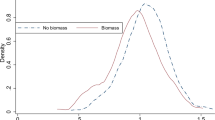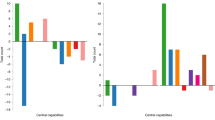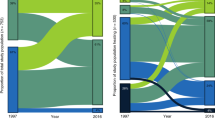Abstract
The association of biomass fuel use with body weight has never been investigated. We therefore examined the effect of biomass fuel use on body weight of adult Ghanaian women. Data from the 2014 Ghana Demographic and Health Survey, a nationally representative population-based survey was analysed for this study. A total of 4751 women who had anthropometric (height and weight) data qualified for inclusion in this study. In linear regression modelling, charcoal use resulted in 3.08 kg (95% CI: 2.04, 4.12) and 0.81 kg/m2 (95%CI: 0.29, 1.33) reduction in weight and body mass index (BMI), respectively, compared to clean fuel (electricity, liquefied petroleum gas and natural gas) use. Use of wood resulted in much higher reduction in weight and BMI. In modified Poisson regression, charcoal users had 19% (Adjusted Prevalence Ratio [aPR] = 0.81; 95%CI: 0.71, 0.92) and 29% (aPR = 0.71; 95%CI: 0.61, 0.83) decreased risk of overweight and obesity, respectively, compared to clean fuel users. Wood users had much higher decreased risk of overweight and obesity. In conclusion, biomass fuel use was associated with reduced body weight and BMI of Ghanaian women and is the first report on the relationship. However, it is important that our findings are confirmed and the biological mechanisms elucidated through rigorous study designs.
This is a preview of subscription content, access via your institution
Access options
Subscribe to this journal
Receive 6 print issues and online access
$259.00 per year
only $43.17 per issue
Buy this article
- Purchase on Springer Link
- Instant access to full article PDF
Prices may be subject to local taxes which are calculated during checkout
Similar content being viewed by others
References
Bonjour S, Adair-Rohani H, Wolf J, Bruce NG, Mehta S, Prüss-Ustün A, et al. Solid fuel use for household cooking: country and regional estimates for 1980–2010. Environ Health Perspect. 2013;121:784–90.
Amegah AK, Jaakkola JJK. Household air pollution and the sustainable development goals. Bull WHO. 2016;94:215–21.
Forouzanfar MH, Afshin A, Alexander LT, Anderson HR, Bhutta ZA, Biryukov S, et al. Global, regional, and national comparative risk assessment of 79 behavioural, environmental and occupational, and metabolic risks or clusters of risks, 1990–2015: a systematic analysis for the Global Burden of Disease Study 2015. Lancet. 2016;388:1659–724.
Ghana Statistical Service (GSS), Ghana Health Service (GHS), ICF International. Ghana Demographic and Health Survey. Rockville: GSS, GHS, and ICF International; 2015; 2014.
McCracken JP, Wellenius GA, Bloomfield GS, Brook RD, Tolunay HE, Dockery DW, et al. Household air pollution from solid fuel use: evidence for links to CVD. Glob Heart. 2012;7:223–34.
Noubiap JJ, Essouma M, Bigna JJ. Targeting household air pollution for curbing the cardiovascular disease burden: a health priority in Sub-Saharan Africa. J Clin Hypertens (Greenwich). 2015;17:825–9.
Smith KR, Mehta S, Feuz M. Indoor air pollution from household use of solid fuels. In: Ezzati M, Rodgers A, Lopez AD, Murray CJL, editors. Comparative quantification of health risk: global and regional burden of disease due to selected major risk factors. Geneva: WHO; 2004. p. 1435–93.
Smith KR, Bruce N, Balakrishnan K, Adair-Rohani H, Balmes J, Chafe Z, et al. Millions dead: how do we know and what does it mean? Methods used in the comparative risk assessment of household air pollution. Annu Rev Public Health. 2014;35:185–206.
Amegah AK, Quansah R, Jaakkola JJK. Household air pollution from solid fuel use and risk of adverse pregnancy outcomes: a systematic review and meta-analysis of the empirical evidence. PLoS One. 2014;9:e113920.
Klesges RC, Meyers AW, Klesges LM. LaVasque M. Smoking, body weight, and their effects on smoking behavior: a comprehensive review of the literature. Psychol Bull. 1989;106:204–30.
Chiolero A, Faeh D, Paccaud F, Cornuz J. Consequences of smoking for body weight, body fat distribution, and insulin resistance. Am J Clin Nutr. 2008;87:801–9.
McConnell R, Shen E, Gilliland FD, Jerrett M, Wolch J, Chang CC, et al. A longitudinal cohort study of body mass index and childhood exposure to secondhand tobacco smoke and air pollution: the Southern California Children’s Health Study. Environ Health Perspect. 2015;123:360–6.
Jerrett M, McConnell R, Wolch J, Chang R, Lam C, Dunton G, et al. Traffic-related air pollution and obesity formation in children: a longitudinal, multilevel analysis. Environ Health. 2014;13:49.
Eze IC, Schaffner E, Foraster M, Imboden M, von Eckardstein A, Gerbase MW, et al. Long-term exposure to ambient air pollution and metabolic syndrome in adults. PLoS One. 2015;10:e0130337.
Li W, Dorans KS, Wilker EH, Rice MB, Schwartz J, Coull BA, et al. Residential proximity to major roadways, fine particulate matter, and adiposity: The Framingham Heart Study. Obes (Silver Spring). 2016;24:2593–259.
James P, Kioumourtzoglou MA, Hart JE, Banay RF, Kloog I, Laden F. Interrelationships between walkability, air pollution, greenness, and body mass index. Epidemiol 2017;28:780–8.
Kermah D, Shaheen M, Pan D, Friedman TC. Association between secondhand smoke and obesity and glucose abnormalities: data from the National Health and Nutrition Examination Survey (NHANES 1999–2010). BMJ Open Diabet Res Care. 2017;5:e000324.
Ofori-Asenso R, Agyeman AA, Laar A, Boateng D. Overweight and obesity epidemic in Ghana - a systematic review and meta-analysis. BMC Public Health. 2016;16:1239.
Scott A, Ejikeme CS, Clottey EN, Thomas JG. Obesity in sub-Saharan Africa: development of an ecological theoretical framework. Health Promot Int. 2013;28:4–16.
ICF international. Measure DHS Biomarker Field Manual. ICF International. Calverton: ICF International; 2012.
Assaf S, Kothari MT, Pullum T. An Assessment of the Quality of DHS Anthropometric Data, 2005–14. DHS Methodological Reports No. 16 Rockville: ICF International; 2015.
Zou G. A modified Poisson regression approach to prospective studies with binary data. Am J Epidemiol. 2004;159:702–6.
Orsini N, Bellocco R, Bottai M, Kuskowska-Wolk A, Greenland S. A tool for deterministic and probabilistic sensitivity analysis of epidemiologic studies. Stata J. 2008;8:29–48.
Sartorius K, Sartorius B, Madiba TE, Stefan C. Does high carbohydrate intake lead to increased risk of obesity? A systematic review and meta-analysis. BMJ Open. 2018;8:e018449.
Galbete C, Nicolaou M, Meeks KA, de-Graft Aikins A, Addo J, et al. Food consumption, nutrient intake, and dietary patterns in Ghanaian migrants in Europe and their compatriots in Ghana. Food Nutr Res. 2017;61:1341809.
Amegah AK, Lumor S, Vidogo F. Prevalence and determinants of overweight and obesity in adult residents of Cape Coast, Ghana: a Hospital-based Study. Afr J Food Agric Nutr Dev. 2011;11:4828–46.
Amoah AGB. Sociodemographic variations in obesity among Ghanaian adults. Public Health Nutr. 2003;6:751–75.
Addo J, Agyemang C, de-Graft Aikins A, et al. Association between socioeconomic position and the prevalence of type 2 diabetes in Ghanaians in different geographic locations: the RODAM study. J Epidemiol Community Health. 2017;71:633–9.
Amegah AK, Nayha S, Jaakkola JJK. Do biomass fuel use and consumption of unsafe water mediate educational inequalities in stillbirth risk? An analysis of the 2007 Ghana Maternal Health Survey. BMJ Open. 2017;7:e012348.
Bruce N, Pope D, Rehfuess E, Balakrishnan K, Adair-Rohani H, Dora C. WHO indoor air quality guidelines on household fuel combustion: Strategy implications of new evidence on interventions and exposure–risk functions. Atmos Environ. 2015;106:451–7.
Bruce N, Perez-Padilla R, Albalak R. The health effects of indoor air pollution exposure in developing countries. Geneva: World Health Organization; 2002.
Naeher LP, Brauer M, Lipsett M, Zelikoff JT, Simpson CD, Koenig JQ, et al. Woodsmoke health effects: a review. Inhal Toxicol. 2007;19:67–106.
Bernstein D. A review of the influence of particle size, puff volume, and inhalation pattern on the deposition of cigarette smoke particles in the respiratory tract. Inhal Toxicol. 2004;16:675–89.
Dare S, Mackay DF, Pell JP. Relationship between smoking and obesity: a cross-sectional study of 499,504 middle-aged adults in the UK general population. PLoS ONE. 2015;10:e0123579.
Ponticiello BG, Capozzella A, Di Giorgio V, Casale T, Giubilati R, Tomei G, et al. Overweight and urban pollution: preliminary results. Sci Total Environ. 2015;518–9:61–4.
Cheng LL, Liu YY, Su ZQ, Liu J, Chen RC, Ran PX. Clinical characteristics of tobacco smoke-induced versus biomass fuel-induced chronic obstructive pulmonary disease. J Transl Int Med. 2015;3:126–9.
Hosick PA, Alamodi AA, Storm MV, Gousset MU, Pruett BE, Gray W, et al. Chronic carbon monoxide treatment attenuates development of obesity and remodels adipocytes in mice fed a high-fat diet. Int J Obes. 2014;38:132–9.
Masera OR, Saatkamp BD, Kammen DM. From linear fuel switching to multiple cooking strategies: a critique and alternative to the energy ladder model. World Dev. 2000;28:2083–103.
Balakrishnan K, Ramaswamy P, Sankar S. Biomass smoke and health risks: the situation in developing countries. Handb Environ Chem. 2004;4:219–39.
Anenberg SC, Balakrishnan K, Jetter J, Masera O, Mehta S, Moss J, et al. Cleaner cooking solutions to achieve health, climate, and economic cobenefits. Environ Sci Technol. 2013;47:3944–52.
Zulu LC, Richardson RB. Charcoal, livelihoods, and poverty reduction: evidence from sub-Saharan Africa. Energy Sustain Dev. 2013;17:127–37.
Acknowledgements
The authors would like to thank Measure DHS for granting them permission to use the 2014 Ghana Demographic and Health Survey (GDHS) data set for this research. We received no funding for this work.
Author information
Authors and Affiliations
Corresponding author
Ethics declarations
Conflict of interest
The authors declare that they have no conflict of interest.
Additional information
Publisher’s note: Springer Nature remains neutral with regard to jurisdictional claims in published maps and institutional affiliations.
Rights and permissions
About this article
Cite this article
Amegah, A.K., Boachie, J., Näyhä, S. et al. Association of biomass fuel use with reduced body weight of adult Ghanaian women. J Expo Sci Environ Epidemiol 30, 670–679 (2020). https://doi.org/10.1038/s41370-019-0129-2
Received:
Revised:
Accepted:
Published:
Issue Date:
DOI: https://doi.org/10.1038/s41370-019-0129-2
Keywords
This article is cited by
-
Independent and combined associations of solid-fuel use and smoking with obesity among rural Chinese adults
Environmental Science and Pollution Research (2021)



